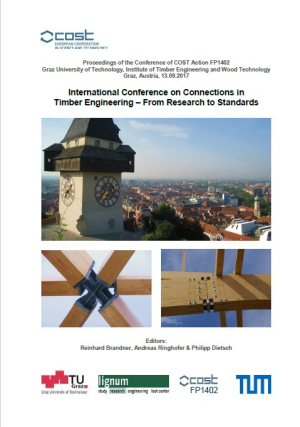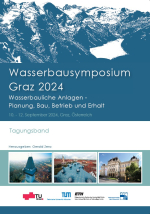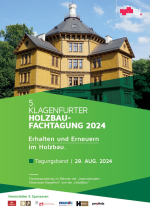It is well known that timber structures succeed or fail in their
connections and significant technical advances and developments in the
field of timber connections have fostered the recent renaissance of
timber as a structural material. Self-tapping screws are prominent
amongst these innovations. They increase timber’s potential by enabling
strong, stiff and economic connections, widening the range for
structural applications. An increased range of connection types and
corresponding applications gives designers both opportunity and
challenge. The result is a noticeable trend towards systemized solutions
enabling quick and reliable assembly on site.
The behaviour of
structures must be both reliable and safe and, for this reason,
construction is highly controlled. This poses the challenge that
innovation has to take place inside a framework of regulation. A lack of
standardized design and construction principles for new developments
could result in a variety of applied approaches that might lead to a
lower reliability of structures at higher cost. A core objective for
COST Action FP1402 is to provide the knowledge and methods necessary to
bring these new developments into regulated building practice.
The
objective of this Conference is to record the current state-of-the-art
for connections in timber engineering, and to illustrate how new
developments will be adopted in the next generation of Timber Design
Standards (e.g. Eurocode 5:2022). It is an opportunity to hear
presentations from some of the world’s leading experts and to join
discussions on the design, application and performance of Connections in
Timber Engineering. There will be presentations on current performance
indicators, (e.g. strength, stiffness and ductile vs. brittle failure
modes), as well as applications of connections in cross-laminated timber
and timber-concrete composite structures. The Conference will also
include presentations on current developments of design rules (e.g. for
brittle failure modes, reinforcement and seismic design) and give an
outlook on the potential of numerical modelling and probabilistic
methods for future design of efficient and reliable connections.
It
is intended that this COST Action FP1402 Conference will contribute to a
high-quality and open scientific and technical dialogue within the
timber engineering community. It thereby adheres to the main principle
of the COST Programme, which is to strengthen Europe in scientific and
technological research, for peaceful purposes, through the support of
cooperation and interaction between researchers and practitioners.
For
many years, the team of the Institute of Timber Engineering and Wood
Technology at Graz University of Technology has been working at the
forefront of timber engineering research and innovation. In 2013, in
collaboration with COST Action FP1004, they hosted a very successful
“Conference on Cross Laminated Timber”. For this current Conference on
“Connections in Timber Engineering”, Graz University of Technology, with
COST Action FP1402, is once again bringing together researchers and
practitioners from around the world to increase understanding of current
and future timber connection research and to discuss applications.
Philipp Dietsch, Chair COST FP1402
Proceedings of the Conference of COST Action FP1402 at Graz University of Technology
published by: Reinhard Brandner, Andreas Ringhofer, Philipp Dietsch
Issue: Open Access E-Book
ISBN: 978-3-85125-554-6
Scope: 233 pages
Language: Englisch
Release date: January 2018
It is well known that timber structures succeed or fail in their
connections and significant technical advances and developments in the
field of timber connections have fostered the recent renaissance of
timber as a structural material. Self-tapping screws are prominent
amongst these innovations. They increase timber’s potential by enabling
strong, stiff and economic connections, widening the range for
structural applications. An increased range of connection types and
corresponding applications gives designers both opportunity and
challenge. The result is a noticeable trend towards systemized solutions
enabling quick and reliable assembly on site.
The behaviour of
structures must be both reliable and safe and, for this reason,
construction is highly controlled. This poses the challenge that
innovation has to take place inside a framework of regulation. A lack of
standardized design and construction principles for new developments
could result in a variety of applied approaches that might lead to a
lower reliability of structures at higher cost. A core objective for
COST Action FP1402 is to provide the knowledge and methods necessary to
bring these new developments into regulated building practice.
The
objective of this Conference is to record the current state-of-the-art
for connections in timber engineering, and to illustrate how new
developments will be adopted in the next generation of Timber Design
Standards (e.g. Eurocode 5:2022). It is an opportunity to hear
presentations from some of the world’s leading experts and to join
discussions on the design, application and performance of Connections in
Timber Engineering. There will be presentations on current performance
indicators, (e.g. strength, stiffness and ductile vs. brittle failure
modes), as well as applications of connections in cross-laminated timber
and timber-concrete composite structures. The Conference will also
include presentations on current developments of design rules (e.g. for
brittle failure modes, reinforcement and seismic design) and give an
outlook on the potential of numerical modelling and probabilistic
methods for future design of efficient and reliable connections.
It
is intended that this COST Action FP1402 Conference will contribute to a
high-quality and open scientific and technical dialogue within the
timber engineering community. It thereby adheres to the main principle
of the COST Programme, which is to strengthen Europe in scientific and
technological research, for peaceful purposes, through the support of
cooperation and interaction between researchers and practitioners.
For
many years, the team of the Institute of Timber Engineering and Wood
Technology at Graz University of Technology has been working at the
forefront of timber engineering research and innovation. In 2013, in
collaboration with COST Action FP1004, they hosted a very successful
“Conference on Cross Laminated Timber”. For this current Conference on
“Connections in Timber Engineering”, Graz University of Technology, with
COST Action FP1402, is once again bringing together researchers and
practitioners from around the world to increase understanding of current
and future timber connection research and to discuss applications.
Philipp Dietsch, Chair COST FP1402
These could also be of interest to you
- Catalog
- New releases
-
Open Access publications

- Enhanced e-books
-
Series
- Akademische Reden an der Technischen Universität Graz
- Arbeitshilfen für die Praxis
- Archiv und Bibliothek
- Betonkolloquium
- Buddhist Architecture in the Western Himalayas
- BWL Schriftenreihe
- Electrical Power Systems
- Fachbücher Planung und Bau
- Facts & Figures
- Festschriften TU Graz
- Forschungsreihe IBBW
- Forum Technik und Gesellschaft
- Geodesy
- Immersive Learning Research Network Conference; Workshop, short papers, poster
- Institut für Gebäudelehre Jahrbuch
- International Brain-Computer Interface (BCI) Meeting
- LM.VM.2014
- Logistik Werkstatt Graz
- Materialien zu Schwerpunkten am Institut für Gebäudelehre
- Mathematical Modelling of Weld Phenomena
- Monographic Series TU Graz
- Monographic Series TU Graz|Advanced Materials Science
- Monographic Series TU Graz|Computation in Engineering and Science
- Monographic Series TU Graz|Production Science and Management
- Monographic Series TU Graz|Railway Research
- Monographic Series TU Graz|Reihe Fahrzeugtechnik
- Monographic Series TU Graz|Schriftenreihe des Instituts Betonbau
- Monographic Series TU Graz|Structural Analysis
- Monographic Series TU Graz|Techno- und sozioökonomisch orientierte Betriebswirtschaft
- Monographic Series TU Graz|Technoökonomie und industrielles Management
- Monographic Series TU Graz|Timber Engineering & Technology
- November Talks
- Proceedings of the International Brain-Computer Interface
- Schriftenreihe des Instituts für Baubetrieb und Bauwirtschaft
- Schriftenreihe des Instituts für Straßen- und Verkehrswesen
- Schriftenreihe des Instituts für Wohnbau der TU Graz
- Schriftenreihe zur Wasserwirtschaft
- Science, Technology and Society online
- Seminarreihe Bauunternehmensführung
- Studien zur Architektur | TU Graz
- Textbook Series
- Transform Industry: Guiding the transformation of SMEs
- TU Graz Jahresbericht | Annual report
- TU Graz people
- TU Graz Research
- VKM-THD Mitteilungen; IVT-Mitteilungen ab Bd. 100
- Authors
- Sale
Contact
Verlag der
Technischen Universität Graz
Technikerstraße 4
8010 Graz, Österreich
UID(VAT) ATU 57477929
contact person
Gabriele Groß
Tel.: +43(0)316 873 6157
E-Mail: verlag [ at ] tugraz.at
Privacy Overview
Necessary cookies are absolutely essential for the website to function properly. These cookies ensure basic functionalities and security features of the website, anonymously.
| Cookie | Dauer | Beschreibung |
|---|---|---|
| cookielawinfo-checkbox-analytics | 11 months | This cookie is set by GDPR Cookie Consent plugin. The cookie is used to store the user consent for the cookies in the category "Analytics". |
| cookielawinfo-checkbox-functional | 11 months | The cookie is set by GDPR cookie consent to record the user consent for the cookies in the category "Functional". |
| cookielawinfo-checkbox-necessary | 11 months | This cookie is set by GDPR Cookie Consent plugin. The cookies is used to store the user consent for the cookies in the category "Necessary". |
| qtrans_front_language | 1 year | This cookie is set by qTranslate WordPress plugin. The cookie is used to manage the preferred language of the visitor. |
| viewed_cookie_policy | 11 months | The cookie is set by the GDPR Cookie Consent plugin and is used to store whether or not user has consented to the use of cookies. It does not store any personal data. |
| woocommerce_cart_hash | session | This cookie is set by WooCommerce. The cookie helps WooCommerce determine when cart contents/data changes. |
Analytical cookies are used to understand how visitors interact with the website. These cookies help provide information on metrics the number of visitors, bounce rate, traffic source, etc.
| Cookie | Dauer | Beschreibung |
|---|---|---|
| _pk_id | 1 year 27 days | Required for the operation of Matomo, an analysis tool that tracks and analyzes user behavior. |
| _pk_ref | 13 months | Required for the operation of Matomo, an analysis tool that tracks and analyzes user behavior. |
| _pk_ses | 30 minutes | Required for the operation of Matomo, an analysis tool that tracks and analyzes user behavior. |
Other uncategorized cookies are those that are being analyzed and have not been classified into a category as yet.
| Cookie | Dauer | Beschreibung |
|---|---|---|
| yt-remote-connected-devices | never | No description available. |
| yt-remote-device-id | never | No description available. |







